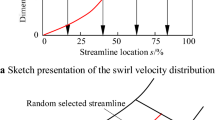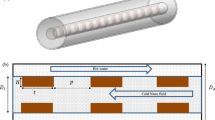Abstract
The channels roughed by ribs have been widely applied in turbine blade internal cooling. A new concept of cooling channels with hybrid ribs (the combination arrangement of rectangular and semicircular ribs) is proposed in this paper. The optimal design and decision making of the new channels are performed to gain the optimal design variables and corresponding heat transfer and flow performance, combining response surface methodology and non-dominated sorting genetic algorithm II. The objective functions (\(\overline{{{\text{Nu}}}} {/}\overline{{{\text{Nu}}}}_{{\text{s}}} ,\overline{f}/\overline{f}_{{\text{s}}}\), and η) corresponding to the optimized design variables (Re, p/e, e/D) are obtained by a series of numerical simulation calculations. The surrogate models are obtained in quadratic polynomial forms, and then, the analysis of variance is utilized to assess the statistical significance of each term in the surrogate models. Pareto-optimal fronts are obtained by NSGA-II, and the Technique for Order Preference by Similarity to Ideal Situation is used to determine the better Pareto-optimal solution. The results indicate that the quadratic term (p/e)2, linear term Re, and linear term Re are the most significant terms for \(\overline{{{\text{Nu}}}} {/}\overline{{{\text{Nu}}}}_{{\text{s}}} ,\overline{f}/\overline{f}_{{\text{s}}}\), and η, respectively. That the optimum objective functions are \(\overline{{{\text{Nu}}}} {/}\overline{{{\text{Nu}}}}_{{\text{s}}}\) = 2.07 and \(\overline{f}/\overline{f}_{{\text{s}}}\) = 4.00, corresponding design variables are Re = 20,571, p/e = 11.43, and e/D = 0.051. The optimal design variables along for various Re are also gained, which possesses guiding significance for cooling channels optimization design.














Similar content being viewed by others
Abbreviations
- c p :
-
Constant pressure specific heat capacity (J kg−1 K−1)
- D :
-
Hydraulic diameter (mm)
- e :
-
Rib height (mm)
- f :
-
Fanning friction factor, approximate function (–)
- H :
-
Channel height (mm)
- I :
-
Turbulence intensity
- k :
-
Turbulence kinetic energy (m2 s−2)
- L :
-
Channel length (mm)
- n :
-
Number of variables (–)
- Nu :
-
Nusselt number (–)
- p :
-
Pressure (Pa), rib pitch (mm)
- Pr :
-
Prandtl number (–)
- q :
-
Heat flux (W m−2)
- Re :
-
Reynolds number (–)
- T :
-
Temperature (K)
- W :
-
Channel width (mm)
- u :
-
Velocity (m s−1)
- X :
-
Design variable (–)
- α :
-
Convective heat transfer coefficient (W K−1 m−2)
- λ :
-
Thermal conductivity (W m−1 K−1)
- μ :
-
Dynamic viscosity (kg m−1 s−1)
- ρ :
-
Density (kg m−3)
- η :
-
Overall heat transfer coefficient (–)
- ε :
-
Turbulence dissipation rate (m3 s−2)
- w :
-
Channel wall
- f:
-
Flow region
- in:
-
Inlet/inside
- o:
-
Outlet/outside
- t:
-
Turbulence
- s:
-
Smooth tube
- ANOVA:
-
Analysis of variance
- CCD:
-
Central composite design
- DF:
-
Degree of model freedom
- DOE:
-
Design of experiments
- NSGA:
-
Non-dominated sorting genetic algorithm
- MS:
-
Mean square
- PRESS:
-
Predicted residual error sum of squares
- RSM:
-
Response surface methodology
- SD:
-
Standard deviation
- SS:
-
Sum of the squares
- TOPSIS:
-
Technique for Order Preference by Similarity to Ideal Situation
References
Chandra PR, Alexander CR, Han JC. Heat transfer and friction behaviors in rectangular channels with varying number of ribbed walls. Int J Heat Mass Transf. 2003;46:481–95.
Gao XF, Sundén B. Heat transfer and pressure drop measurements in rib-roughened rectangular ducts. Exp Therm Fluid Sci. 2001;24:25–34.
Rau G, Monde M, Moeller D, Arts T. The effect of periodic ribs on the local aerodynamic and heat transfer performance of a straight cooling channel. J Turbomach. 1998;120:368–75.
Acharya S, Agarwal P, Nikitopoulos DE. Heat/mass transfer in a 4:1 AR smooth and ribbed coolant passage with rotation in 90-degree and 45-degree orientations. Vienna, Austria; 2008.
Islam SM, Haga K, Kaminaga M, Hino R, Monde M. Experimental analysis of turbulent flow structure in a fully developed rib-roughned rectangular channel with PIV. Exp Fluids. 2002;33:296–306.
Han JC, Park JS. Developing heat transfer in rectangular channels with rib turbulators. Int J Heat Mass Transf. 1988;31:183–95.
Chang SW, Liou TM, Chiang KF, Hong GF. Heat transfer and pressure drop in rectangular channel with compound roughness of V-shaped ribs and deepened scales. Int J Heat Mass Transf. 2008;51:457–68.
Chang SW, Liou TM, Lee TH. Thermal performance comparison between radially rotating ribbed parallelogram channels with and without dimples. Int J Heat Mass Transf. 2012;55:3541–59.
Choi EY, Choi YD, Lee WS, Chung JT, Kwak JS. Heat transfer augmentation using a rib-dimple compound cooling technique. Appl Therm Eng. 2013;51:435–41.
Shen Z, Xie Y, Zhang D. Numerical predictions on fluid flow and heat transfer in U-shaped channel with the combination of ribs, dimples and protrusions under rotational effects. Int J Heat Mass Transf. 2015;80:494–512.
Singh P, Ekkad S. Experimental study of heat transfer augmentation in a two-pass channel featuring V-shaped ribs and cylindrical dimples. Appl Therm Eng. 2017;116:205–16.
Singh P, Pandit J, Ekkad SV. Characterization of heat transfer enhancement and frictional losses in a two-pass square duct featuring unique combinations of rib turbulators and cylindrical dimples. Int J Heat Mass Transf. 2017;106:629–47.
Jaurker AR, Saini JS, Gandhi BK. Heat transfer and friction characteristics of rectangular solar air heater duct using rib-grooved artificial roughness. Sol Energy. 2006;80:895–907.
Layek A, Saini JS, Solanki SC. Heat transfer and friction characteristics for artificially roughened ducts with compound turbulators. Int J Heat Mass Transf. 2007;50:4845–54.
Eiamsa-ard S, Promvonge P. Thermal characteristics of turbulent rib-grooved channel flows. Int Commun Heat Mass Transf. 2009;36:705–11.
Alfarawi S, Abdel-Moneim SA, Bodalal A. Experimental investigations of heat transfer enhancement from rectangular duct roughened by hybrid ribs. Int J Therm Sci. 2017;118:123–38.
Papila N, Shyy W, Griffin L, Dorney D. Shape optimization of supersonic turbines using response surface and neural network methods. Reno, Nevada; 2013.
Shyy W, Papila N, Vaidyanathan R, Tucker K. Global design optimization for aerodynamics and rocket propulsion components. Prog Aerosp Sci. 2001;37:59–118.
Samad A, Kim K-Y, Goel T, Haftka RT, Shyy W. Multiple surrogate modeling for axial compressor blade shape optimization. J Propuls Power. 2008;24:301–10.
Kim HM, Moon MA, Kim KY. Multi-objective optimization of a cooling channel with staggered elliptic dimples. Energy. 2011;36:3419–28.
Kim KY, Shin DY. Optimization of a staggered dimpled surface in a cooling channel using Kriging model. Int J Therm Sci. 2008;47:1464–72.
Samad A, Lee KD, Kim KY. Multi-objective optimization of a dimpled channel for heat transfer augmentation. Heat Mass Transf und Stoffuebertragung. 2008;45:207–17.
Deb K. Multi-objective optimization using evolutionary algorithms multi-objective optimization using evolutionary algorithms. Wiley; 2001.
Samad A, Kim K-Y. Surrogate based optimization techniques for aerodynamic design of turbomachinery. Int J Fluid Mach Syst. 2009;2:179–88.
Deb K, Pratap A, Agarwal S, Meyarivan T. A fast and elitist multiobjective genetic algorithm: NSGA-II. IEEE Trans Evol Comput. 2002;6:182–97.
Esfe MH, Hajmohammad H, Toghraie D, Rostamian H, Mahian O, Wongwises S. Multi-objective optimization of nanofluid flow in double tube heat exchangers for applications in energy systems. Energy. 2017;137:160–71.
Seo JW, Afzal A, Kim KY. Efficient multi-objective optimization of a boot-shaped rib in a cooling channel. Int J Therm Sci. 2016;106:122–33.
Damavandi MD, Safikhani H, Yahyaabadi M. Multi-objective optimization of asymmetric v-shaped ribs in a cooling channel using CFD, artificial neural networks and genetic algorithms. J Braz Soc Mech Sci Eng. 2017;39:2319–29.
Haasenritter A, Weigand B. Optimization of the rib structure inside cooling channels with genetic algorithms. Int J Des Nat. 2007;1:116–34.
Yang YT, Chen PJ. Numerical optimization of turbulent flow and heat transfer characteristics in a ribbed channel. Heat Transf Eng. 2015;36:290–302.
Hwang CL, Lai YJ, Liu TY. A new approach for multiple objective decision making. Comput Oper Res. 1993;20:889–99.
Orszag SA, V. Yakhot, Flannery WS, Boysan F, Choudhury D, Maruzewski J, et al. Renormalization group modeling and turbulence simulations. int conf near-wall turbul flows, Tempe, Arizona. 1993.
Han JC, Park JS, Ibrahim MY. Measurement of heat transfer and pressure drop in rectangular channels with turbulence promoters. 1986.
Deb K, Agrawal S, Pratab A, Meyarivan T. A fast and elitist multi-objective genetic algorithm: NSGA-II. IEEE Trans Evol Comput. 2002;6:182–97.
Feng Y, Hung TC, Zhang Y, Li B, Yang J, Shi Y. Performance comparison of low-grade ORCs (organic Rankine cycles) using R245fa, pentane and their mixtures based on the thermoeconomic multi-objective optimization and decision makings. Energy. 2015;93:2018–29.
He C, Zhang Q, Ren J, Li Z. Combined cooling heating and power systems: sustainability assessment under uncertainties. Energy. 2017;139:755–66.
Ge Y, Liu Z, Sun H, Liu W. Optimal design of a segmented thermoelectric generator based on three-dimensional numerical simulation and multi-objective genetic algorithm. Energy. 2018;147:1060–9.
Acknowledgements
The authors gratefully acknowledge the support by the scientific research start-up funds for introducing talent in the Sichuan University (Grant No. 20822041C4013); the National Natural Science Fund (Grant No. 51506034)
Author information
Authors and Affiliations
Corresponding author
Additional information
Publisher's Note
Springer Nature remains neutral with regard to jurisdictional claims in published maps and institutional affiliations.
Rights and permissions
About this article
Cite this article
Yu, R., Han, H., Yang, C. et al. Optimal design and decision making of an air cooling channel with hybrid ribs based on RSM and NSGA-II. J Therm Anal Calorim 147, 5839–5854 (2022). https://doi.org/10.1007/s10973-021-10807-1
Received:
Accepted:
Published:
Issue Date:
DOI: https://doi.org/10.1007/s10973-021-10807-1




